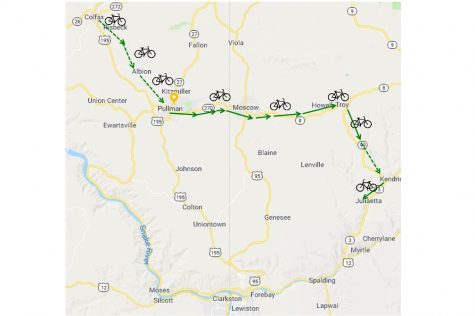Palouse community deserves connecting trail
Additions to existing trails would stretch 50 miles, provide access to nature across Washington, Idaho
LUKE HOLLISTER | DAILY EVERGREEN FILE
The goal of the proposed path extensions is to make the beauty of the Palouse more accessible for residents and visitors.
February 21, 2018
The Palouse may see a 50-mile route created after decommissioned railroads are converted and connected to existing paths. This would span from Colfax to Juliaetta, Idaho, if a project by the Pullman Civic Trust receives proper funding. While this trail may face a small amount of opposition, its benefits for community members certainly outweigh any cons.
The rail would require railbanking, a familiar practice in the Inland Northwest area. When a section of train tracks goes out of commission, a trail manager can acquire ownership and convert it into a public trail. They are then responsible for the trail’s maintenance.
Lisa Carloye, a clinical assistant professor of biological sciences at WSU and president of Pullman Civic Trust, has spent the past year creating awareness for this project. Carloye is appealing to multiple groups, including ASWSU, to form a coalition who would fund and maintain the trail.
“The advantage of railbanking is that it preserves the public right of way,” Carloye said, “and then it also allows it to be used for public benefit.”
The current railbanking project is a 19-mile segment that will connect separate trails, ultimately creating a 50-mile route spanning across the two states.
Carloye grew up in Pullman and left for a period to pursue her career. However, her love for the Palouse brought her back to the area after 25 years.
“I looked at [the Chipman Trail] from afar and thought, ‘Gosh why couldn’t that have been there when I was a teenager?’ ” Carloye said. “It really transformed the community.”
Like the Bill Chipman Palouse Trail, a 7-mile connection between Pullman and Moscow, the expanded trail has the potential to be extremely popular. It was also supported by Pullman Civic Trust.
Railbanking would be dependent on a coalition committed to dividing the funding for conversion and maintenance of the railroads, Carloye said. The Chipman trail is organized this way.
Sponsors like WSU, University of Idaho and Whitman County pay the Chipman trail’s yearly fee for maintenance.
The benefits from this potential trail are numerous. Community members can improve their health, both mental and physical. The trail offers free potential transportation for those who commute into town. A 50-mile trail may also draw tourism to the area.
“The thing about trails that I think is so cool is that they are for everybody,” Carloye said. “It doesn’t matter about your income level, it doesn’t matter about your age. We see people who are 90 years old out on the trails.”

The proposed trail connections (dashed lines) would connect already built trails along the Palouse.
The best thing about this trail might be that it is free and accessible for anyone who wants to use it.
“One of our county commissioners said that he saw a couple out on the trail to Coeur d’Alene on a tandem bicycle,” Carloye said. “The man was in the front and his wife was in the back and she was on an oxygen tank. And he thought, ‘There it is. Anyone can use these trails.’ ”
The biggest opponents of railbanking are the adjacent landowners. While public access expands to the rolling wheat fields, the trail may compromise some people’s solitude.
“Their fear is a loss of privacy and a loss of rural tranquility of living in that world,” Carloye said. “I acknowledge that. It is going to impact people who live close to the trail.”
This may not be ideal, but the community benefits make the tradeoff worthwhile.
“I love the Palouse. It’s just the most beautiful, peaceful and wonderful place,” Carloye said. “For the most part it’s all privately owned. It’s hard to get out in any kind of peaceful setting to really appreciate and experience the landscape. I think that trails provide that avenue without trespassing.”
Everyone deserves access to the Palouse. Railbanking provides public access while benefiting our community’s health and leisure.
It is important for community projects like this to have support. With more awareness and commitment of funding, the railbanking project should become a point of pride for our community.









